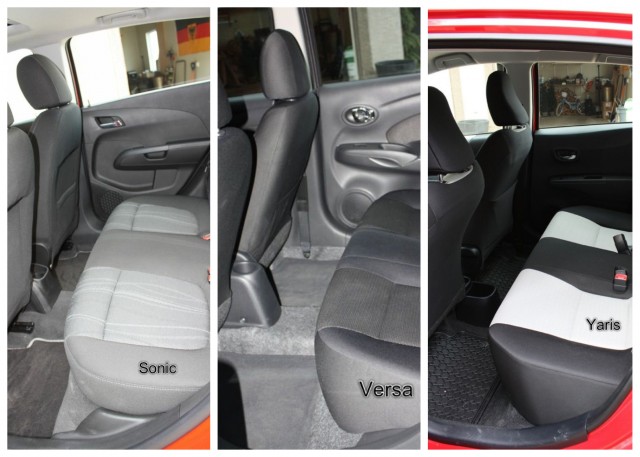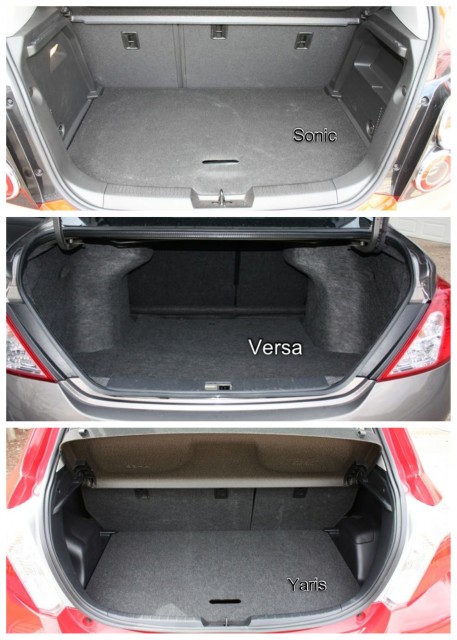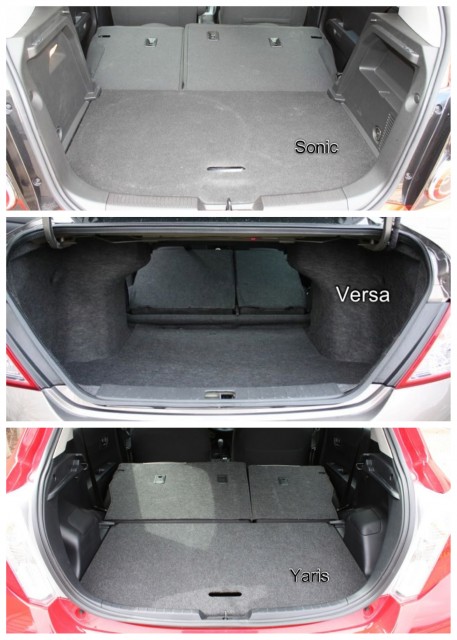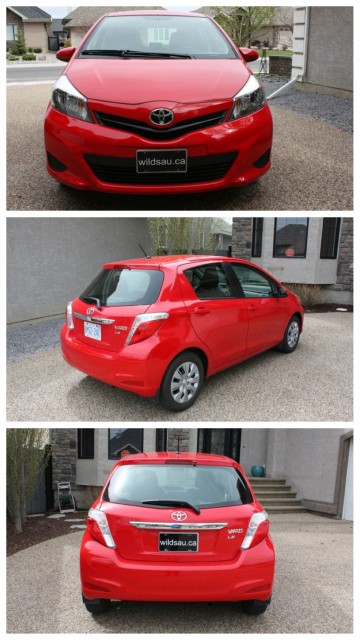I wouldn’t call it an exciting category of cars, but that doesn’t make it any less important. This week I’m going to compare three sub-compacts that, for the most part, compete with each other and are often the way into vehicle ownership for first-time buyers. It’s almost shocking to see how low these cars start off in terms of price, but as with any vehicle, it’s not hard to bring that price up quickly.
I spent a week with each of these bad boys, and each one brought a surprise or two to the party. It’s a pretty slow, laid-back and basic party, mind you, but a party nevertheless. And they’re not really bad. They wish they were.
As I break them down, I’m going to try to stick to the same order – just to be clear, there’s no particular rhyme or reason behind the order, other than alphabetic. S, V, Y. Cool? Cool. Let’s git er dun.
Introductions/Under The Hood
The Sonic is Chevrolet’s almost-smallest offering, but the brand-new Spark is even smaller. Sonics start at CDN $14,495. I drove the LT model, and as tested it was CDN $22,235. Let’s peg the competitive price at $20,540, taking off the upgrade to the 17″ rims, sunroof, tire pressure monitoring system and metallic paint upgrade. Under the hood sits a 1.8 Litre inline-4. It’s the jock of the bunch here, putting out 138 HP @ 6300 RPM and 125 lb.ft of torque at 3800 RPM and it feeds that through a 6-speed automatic transmission. Unfortunately the Sonic is also the heavy-weight in the comparo, tipping the scales at 2745 pounds around.
GM rates the Sonic at 8.3 L/100 km (28 mpg) in the city and 5.5 L/100 km (42.8 mpg) on the highway. During mostly city driving with a slightly heavier foot, I averaged 8.2 L/100 km (28.7 mpg). The Sonic has a 46 Litre tank.
Nissan’s Versa came in the 1.6 SL sedan version. Versas start at CDN $16,298 – my review sample rang in at CDN $18,700 all-in, which includes the exceptionally well-priced $800 navigation system, USB input and satellite radio. Nissan’s 1.6-Litre inline-4 puts out 109 HP @ 6000 RPM and a meh 107 lb.ft of torque at 4400 RPM. All this raw power gets transferred to one of my least-favorite of automobile innovations, a CVT transmission. Thankfully, this mill doesn’t have to schlepp as much weight around – the Versa sedan is only 2407 pounds.
Nissan pegs its fuel economy at 6.7 L/100 km (35 mpg) in the city and a fantastic 5.2 L/100 km (45.2 mpg) on the highway. Again, during mostly city driving but more economically, I averaged 6.9 L/100 km (34 mpg). Quite impressive. The tank is 41 Litres.
And finally we have Toyota’s Yaris. I got the LE 5-door version. Yaris’ (or is it Yarii?) start at CDN $15,890, and this one totaled out at CDN $19,475 all-in, which included a shocking “Convenience Package” that gives you neat things like air conditioning, POWER windows, cruise control, etc. I’d recommend going with that. I didn’t even know you could buy crank-down windows in North America anymore. What are we? ANIMALS?! Where were we? Oh right. The Yaris. Toyota’s 1.5-Litre inline-4 makes 106 HP @ 6000 RPM and a paltry 103 lb.ft of torque at 4200 RPM. Here’s another kicker – at this price, you paid a grand to upgrade to the 4-SPEED AUTOMATIC transmission. When’s the last time you heard that? It seems like a bit of a kick in the shorts to have to pay $1000 for technology that has existed in Toyota’s parts bins for 20 years, especially when the competition is using 6 speeds (see the Sonic). The Yaris is the feather-weight here, at 2249 pounds.
Toyota puts the fuel economy numbers at 6.8 L/100 km (34.6 mpg) in the city and 5.5 L/100 km (42.8 mpg) on the highway. Driving most city again, and not trying to save fuel, I averaged 6.9 L/100 km (34 mpg) during my week with it. Which is the same as the Versa. Which is good. The Yaris’ tank is 41 Litres.
Advantage: Sonic, but not by as much as I thought it would be. The Yaris proved to be a bit of a surprise and with its fuel economy was a close second.
Exterior
Although the Sonic is here to replace the Aveo, I still see some Aveo in the lines, but overall, I really like the shape of this little hatch. It has fun lines, and they integrated the rear door’s handle into the black trim up high, so you wouldn’t be blamed for thinking it’s a little coupe at first. The front end has a hint of aggression and fun, with interesting light clusters that are surprisingly exposed instead of being covered by a nice smooth lens. I like it, but my friend Don Nault (who also reviews cars and may qualify as one of the nicest people in the world) pointed something out to me. He’s got experience in detailing cars, and he mentioned that cleaning those light clusters after a road trip would be an absolutely nightmare. Great point! Overall though, I think they did a good job of evolving the shape.
The Versa – where do I start? Erm, well let me put it this was: I almost invariably choose hatchbacks over their sedan brethren, and that would be my choice here too. Vehicle styling is obviously a very personal thing, but the Versa sedan’s styling is just not to my liking. I thought it was OK from close-up, but when I stood back, I couldn’t help but see a shmooshed jelly bean. The small wheels don’t do the side profile any favors either. I actually thought the front end was quite handsome, and brought a hint of its Infiniti genetics with the swept-back headlights and the grille. The rear end is not bad either, but I found the side view to be quite unflattering.
The Yaris’ styling struck me as a slightly shrunken Matrix. It’s not pretty, but it has character. Toyota certainly pushed the wheels out to the corners, with very little rear overhang. At the front, you’ll find a short, stubby hood. There is a single, huge windshield wiper. I was pretty much neutral on the Yaris’ exterior – it’s nothing much to look at, but it’s not offensive.
Advantage: Sonic
Interior
In this class, you tend to expect less, since you’re paying less.
The Sonic’s manually-adjustable fabric seats were very comfortable, and even had decent side bolstering. Which was balanced out by the basically non-existent thigh bolstering which lets your butt slide all over Creation during cornering. You’re surrounded by hard plastics, with some nice textures. I didn’t think the interior was pretty, but it’s functional and roomy enough. There is a decent steering wheel, with buttons for handsfree, phone, media and cruise control functions. Behind the wheel sits a “motorcycle-inspired” instrument pod that sort of perches on the dash. You get a large tach and to the right, a large driver information screen.
The centre stack has the media system on top and a manual climate control system below. The console houses the shift lever (with a thumb-controlled manual shift toggle – ugh!) and a parking brake. I didn’t like how narrow the armrests on the door panels were, and wasn’t impressed that they weren’t padded.
The Versa’s interior is very basic and simple. At first it came across as very rental-car, but its simplicity grew on me. Hard plastics abound, with a couple of splashes of brighter colors, and upholstered door panels. I was unable to get comfortable in the manually adjustable seats. When driving, they offered decent thigh bolstering but the side bolstering left much to be desired. The headroom in front is excellent! The steering wheel had a thin, spongy-feeling rim (read: not good), and has controls for media, phone and the cruise control. Behind it sit two very clear gauges, and a driver information screen.
The Versa’s centre stack starts with a small screen surrounded by hard buttons and a manual climate control system underneath. The console has a very simple shift lever and the parking brake.
The Yaris’ reasonably spacious interior had decent manually adjustable seats with contrasting inserts – bolstering was not great. The steering wheel is very nice and feels right with a fat rim – interestingly, there are no buttons on it. All controls are within an easy reach, so that’s not really an issue to me. You’re in a sea of mostly hard plastics, with a couple of soft-touch zones on the dash and doors. The gauge cluster is simple and easy to read.
The centre stack has a media system at the top, in an interesting swoosh of lighter colored material that stretches over from the right door panel, and then a manual climate control system underneath. The console has the shift lever at the front and a parking brake lever at the back.
Advantage: Sonic – although it’s not a beautiful interior, it struck me as less rental-car than the other two and would be the one I’d rather live with. With that said, the simplicity of the other two did grow on me, and they are all highly functional.
Tech/Convenience
In this class, this category is mercifully short, as the tech toys are few and far between.
The Sonic offers a basic stereo, feeding off AM, FM, CD and auxiliary sources. It sounds pretty good. There’s a 12V plug on the console. Headlights are automatic, and overhead, you’ll find a tilt/slide sunroof with a manual sliding shade. I found the Sonic’s voice recognition technology to be exemplary – as with other GM products of late – it was quick and never made a mistake.
The driver information screen always shows a digital speedometer, a compass and your gear selection. You can slip through average fuel economy, elapsed driving time, average speed, fuel range, your odometer and a trip meter. It’s a little too busy on that screen, but it works fine.
The Versa dropped its first trump card here. The media, phone and navigation(!!!) functionality is all handled by a small 5″ touchscreen. This was definitely the pinnacle of interacting with those technologies in this test. The screen was highly readable for its small size, and the user interface is quite intuitive after using it for a minute or two, combining touchscreen function with surrounding hard buttons and a scroll/push knob. The stereo offers AM, FM, satellite, auxiliary, USB and CD sources and has acceptable sound.
The navigation system, considering the class of car and the price of the system, was very good. I was impressed by the voice command system as well. The USB and a 12V plug are found on the console, and there’s a driver information screen which lets you display fuel range, instant and average fuel economy, 2 trip meters or your odometer.
The Yaris felt pretty low-tech. Oh right, that’s because it is. It has a basic stereo with AM, FM, CD and Bluetooth streaming audio – it does not sound good. At all. There’s a driver information screen letting you access your odometer, 2 trip meters, instant and average fuel economy, fuel range and your average speed.
There’s a 12V plug at the bottom of the centre stack, and an “Eco” drive indicator, which tells you when you’re driving economically.
All three contenders had cruise control, good (or great) Bluetooth phone integration, and they all had power windows, door locks and mirrors. Although the windows were a close one on the Yaris.
Advantage: Versa – the touchscreen (which includes navigation) is a game changer in this class when you’re looking at cabin tech
Rear Seats
Chevy’s Sonic surprised with a reasonably spacious rear seating area, considering how tiny this car is. There are 3 seats, 3 seat belts and 2 head rests. The room is acceptable for 2 adults, but it’s snug. Getting up to 3 kids back there, on the other hand, is just fine. Kids’ seats fit well, and there are 2 LATCH anchors. In terms of convenience, there’s a combined storage bin and cupholder at the back of the center console.
Here’s where the Versa came shiny-side up. It also has 3 seats and 3 seat belts, but the headroom and more importantly the leg room is excellent! I admit, I was shocked the first time I saw how much leg room it had in the back. There are cars that move up a class or two in terms of size that don’t offer this kind of room in the back. Entry level limo, anyone? It’s plenty comfortable for 2 adults, and no problem for 3 kids. There’s no storage but for the two cupholders at the back of the centre console.
All three cars offer 2 sets of LATCH anchors for kids’ seats.
Advantage: Versa – I was choked about the lack of storage, but the space offered makes up for it.
Storage
The Sonic did a great job providing places to put stuff. From a little tray on the dash, to the vertical slots flanking the centre stack, to the reasonably big glove compartment, to the cool cubbyhole storage with flip-up lid ABOVE the glove compartment, to the big open bin at the bottom of the centre stack with the rubberized bottom… see what I mean? Not to mention 2 inline cupholders, and stubby but big door pockets.
The trunk space was decent, especially considering the size of the car. It offers 19 cubic feet, which grows to 30.7 cubic feet with the seats folded down. I found the biggest limitation in the Sonic’s cargo area was it’s width.
The Versa had less to offer in the cabin. The door bins are skinny slots with integrated bottle holders, and there are 2 cupholders in the console. But the trunk felt cavernous. It’s only 14.8 cubic feet with the rear seats up, but the proportions are such that it is a highly usable space. I was unable to find specifications for the cargo space with the seats down, but suffice it to say it would be a lot, though the space isn’t consistent straight through from front to back like a hatchback would be.
The Yaris made its small-carness known in the storage department. Sure, there is some help in the cabin – small door pockets with bottle holders, a big glove compartment and a bin in the top left of the dash. The console provides 2 cupholders and another small bin. But the trunk space, covered with a hard tonneau lid, looked decent at first but turned out to be tiny, offering only 9.3 cubic feet with the rear seats up.
All three cars’ rear seats split 60/40 when folding them down.
Advantage: Sonic, with the Versa running a very close second place
The Drive
I’m a big fan of how small cars drive, and this comparo reaffirmed my love for these little urban warriors. Well, some of them. None of them are fast, but all are competent and have enough power for basic everyday driving.
The Sonic had enough punch that you’d never feel stranded if you need to pull into traffic. Of course the up-level turbo engine would be nice, but it’s more money. I like the snarl of the inline-4, but it got buzzy and rough over 4000 RPM. The transmission, while relatively intelligent and mostly being in the right gear, is a bit slushy and the manual shift mode is downright sluggish. I also found that, when stepping on it, the RPMs often floated for a second with the shifts.
The ride was very good, and well-damped, but noise insulation was lacking – I often found engine and road noise creeping in. The handling was excellent, and I found the car very confident around corners even though there is quite a bit of body roll. It was fun to drive and easy to shoot out of corners. I found the Sonic happily got up to highway speeds, but wandered a tiny bit at higher speeds and the road noise was a factor there too. That said, I thought the wind noise was low. Visibility is quite good, but there’s a bit of a tunnel out the back because of the rear headrests – I wish they folded down like the ones in the Ford Fiesta I reviewed.
Nissan’s Versa was the least impressive driving machine here. I’ve made it pretty clear how I feel about CVTs. I get that they do well for fuel economy. Otherwise, there’s nothing that entices a driver. Nissan actually does some of the best CVTs in the business, but it’s the ones mated to their 2.5- and 3.5-Litre engines. This one did OK around town, but under throttle, the whiny, irritating way it revs and holds the engine is there, and the rubber-band feeling is too. Ugh. It’s not a fast car, but when you need power, it’s a bit scary – passing on the freeway requires the 3 P’s – patience, planning and prayer. The CVT actually makes this car feel slower than it is.
Yet the CVT isn’t the worst part. The handling is. It’s spongy around corners, but worst of all is the body roll. It’s excessive. I mean 1970’s Cadillac Seville excessive. I mean Rover Police Car excessive.
Oh, there’s more. The brakes? Inspired by Sponge Bob. Wind noise? Very loud at highway speeds. OK, so it’s not all bad, and the Versa does redeem itself at times. Cruising around town, while mundane, is a very quiet affair, and the ride is fantastically damped and quiet. Visibility is quite good, and those thick, angular rear pillars don’t intrude as much as I feared they would. All in all, it’s not horrible, but it’s just no fun to drive.
The Yaris sits somewhere in between. It was relatively quiet at city speeds, but I heard a lot of road noise coming through the tires. The ride and handling were both OK, and you could chuck it into a corner, but there was quite a bit of body roll. Mind you, compared to the Versa, this thing is track ready in terms of handling.
It’s certainly not a quick car, but I was surprised at how satisfying it was to drive. I tried to be pissed off at the meager 4 speed automatic, yet it proved to be the most competent of all these varied transmissions. It’s irritating to have to pay $1000 for something that seems ancient, but somehow the argument seems moot when it works better than the rest of them here. Everything the Yaris did, it did smoothly – it drives smoothly, it shifts smoothly, it handles smoothly, it rides (pretty) smoothly. The visibility out of the Yaris is quite good, except those rear pillars are thick and they impact your shoulder checking ability.
Advantage: a Three-Way Tie for very different reasons – Yaris came across as a do-no-wrong, down-the-middle player; Sonic was the only one that I’d chalk up for a bit of fun, and the lamented Versa did have the best, most-refined ride of the bunch
Nitpicks
The rear armrests on the outboard sides of the Sonic were tiny narrow slivers of real estate, taunting you, daring you to try to put your elbow on them and get comfortable. That’s not cool if you’re stuck back there for a road trip.
I ding both Japanese, make that ALL Japanese, cars for not having the 3 blinks when you tap the signal light stalk. That’s as essential as a toilet to me, and that they continue to exclude that feature just baffles me. HEY! Imagine a toilet built into the driver’s seat of any of these? Now we’re talking! Tech AND convenience. SOLD!
The Versa had some weird omissions that puzzled me. There is no mirror on the driver’s side sun visor. Really? Even Ladas had those, man! There is no grab handle inside the trunk, so closing it requires you to put your hand on top, and possibly getting dirty. Oh, and if you want to open it from the outside? You can’t. There’s no external trunk release button. Finally, the nav system, although cool and a great feature at this price, takes half an eternity to calculate a route. One time, while I was waiting, I just walked across the city to check my own route calculation and got back in time before it finished. OK, it’s not that bad, but it’s really slow.
Looking back, I see that I basically didn’t have any nitpicks that stood out for the Yaris. Hmmm.
The Verdict
This was a tough one. Each car has some great strengths and some significant weaknesses. No car at this price point could be considered near-perfect, so I’d be a fool to expect that. I rated them on my usual scale, in terms of this class, and in relation to each other.
I give the Chevy Sonic a 7 out of 10, the Nissan Versa a 6 out of 10, and the Toyota Yaris a 6.5 out of 10.
Each of these cars would be a fine to live with, as long as you’re aware of the limitations. None are going to win any drag races, none are going to move pianos, and none will boggle the mind with the wealth of tech and luxury within. But all are competent transportation, and all three will do well in terms of fuel economy and all three came across as very well-built.
WAF (Wife Acceptance Factor) hovered between middling and low for the Yaris and the Versa (down a few points on styling, Toyota and LOTS of points lost for not having a driver’s vanity mirror, Nissan!), and was quite high for the Sonic. She liked the Sonic’s drive, and the color, which I thought was a bit too much and inspired by Chernobyl. She’s a funny woman, that one.
So that’s it. It’s not a category that gets our hearts pumping, but it’s a category born of reality, and many of us are looking at vehicles right smack dab in the middle of it for a variety of reasons.
It might not be much fun, but you get more for your money than ever before.
Disclosure: Vehicles were provided by Chevrolet, Nissan and Toyota.
If you enjoyed this review, feel free to check out my other vehicle reviews under the car reviews tab at the top of my blog.












